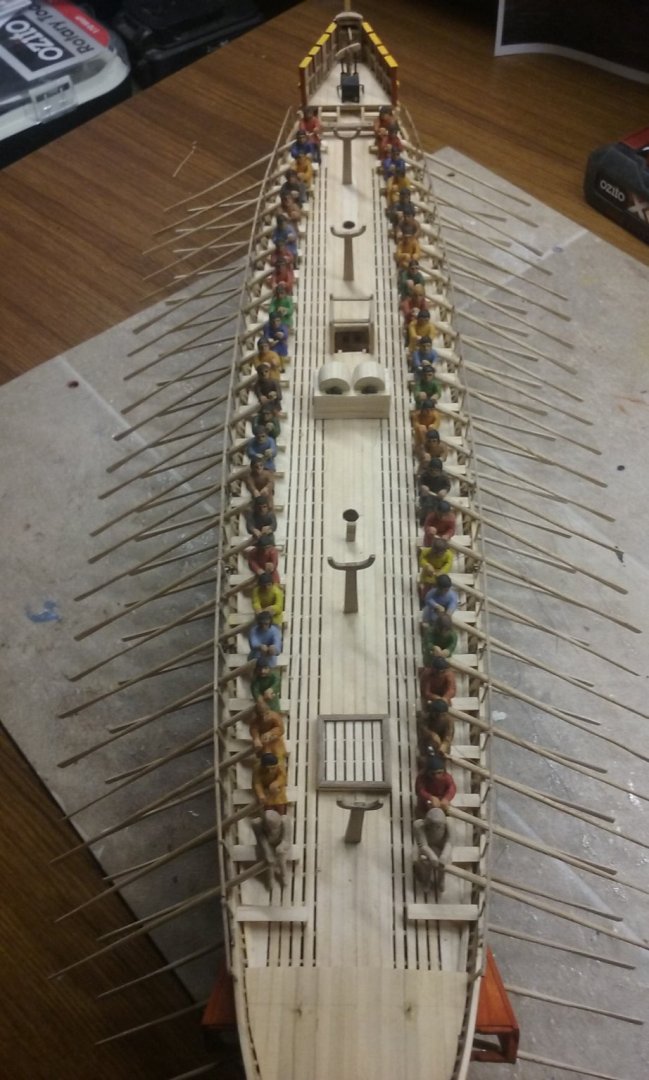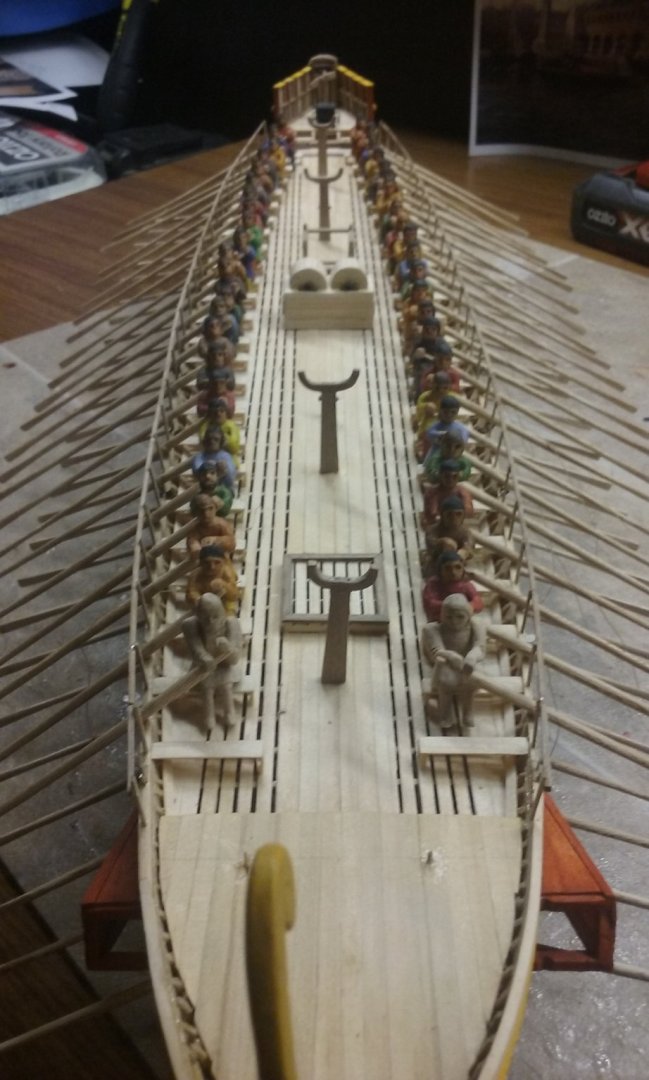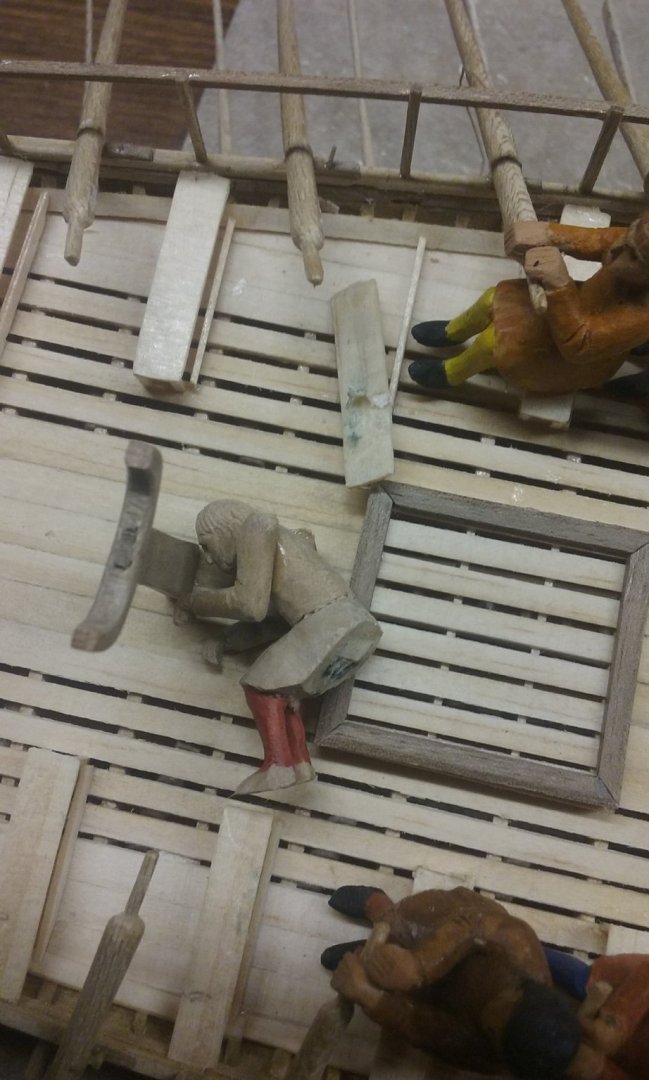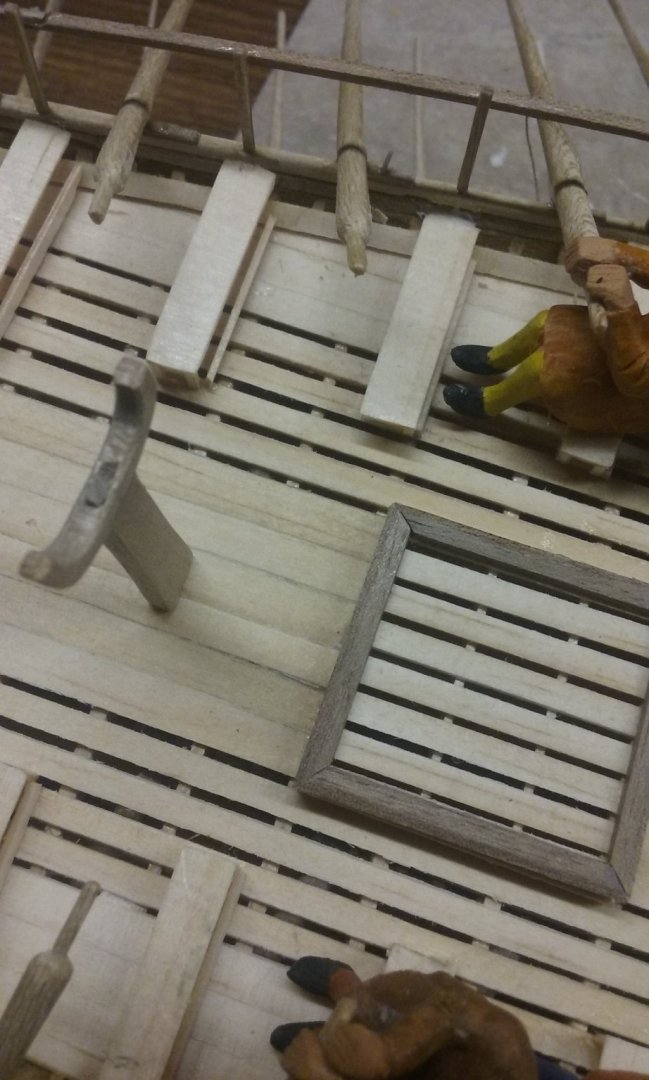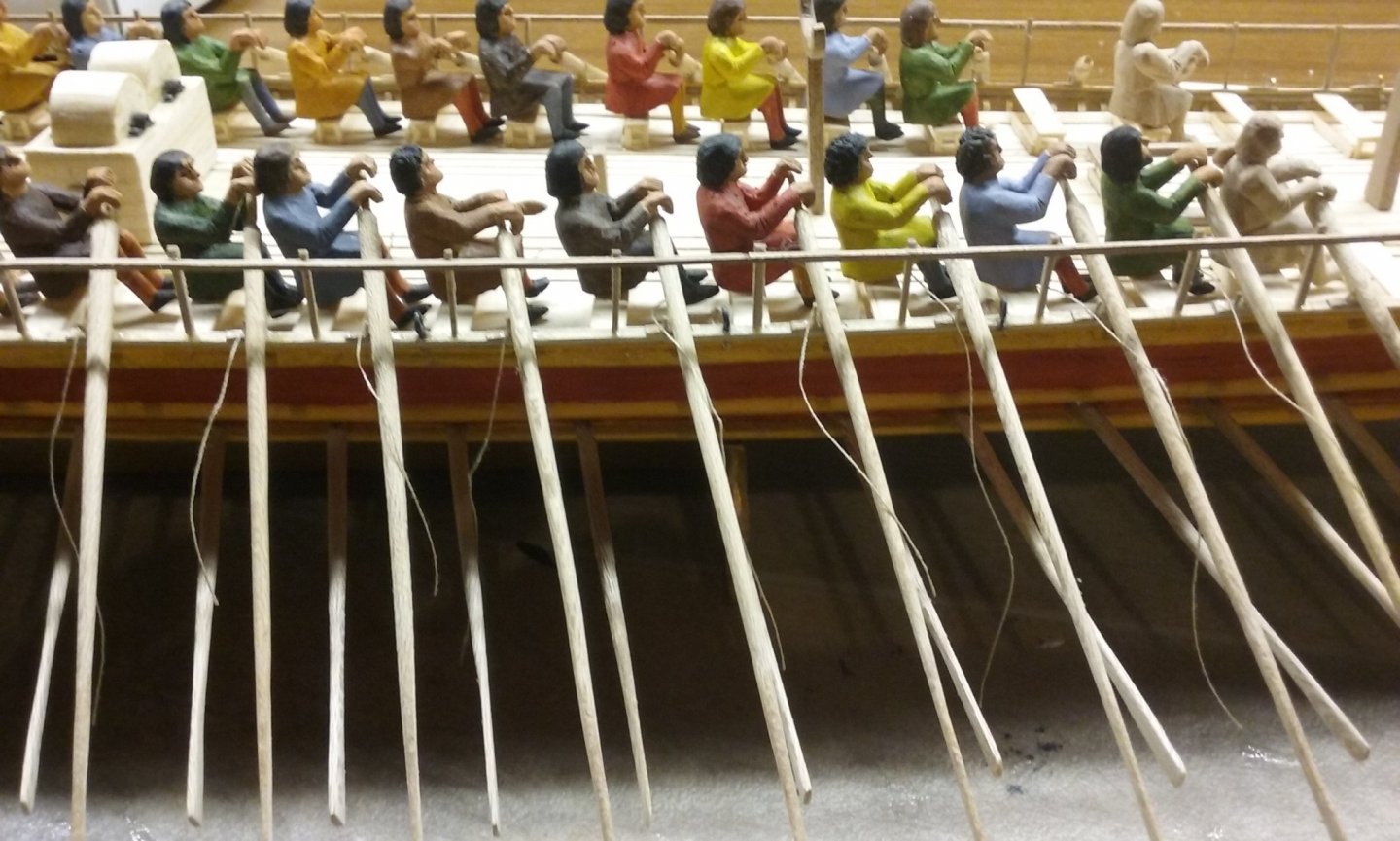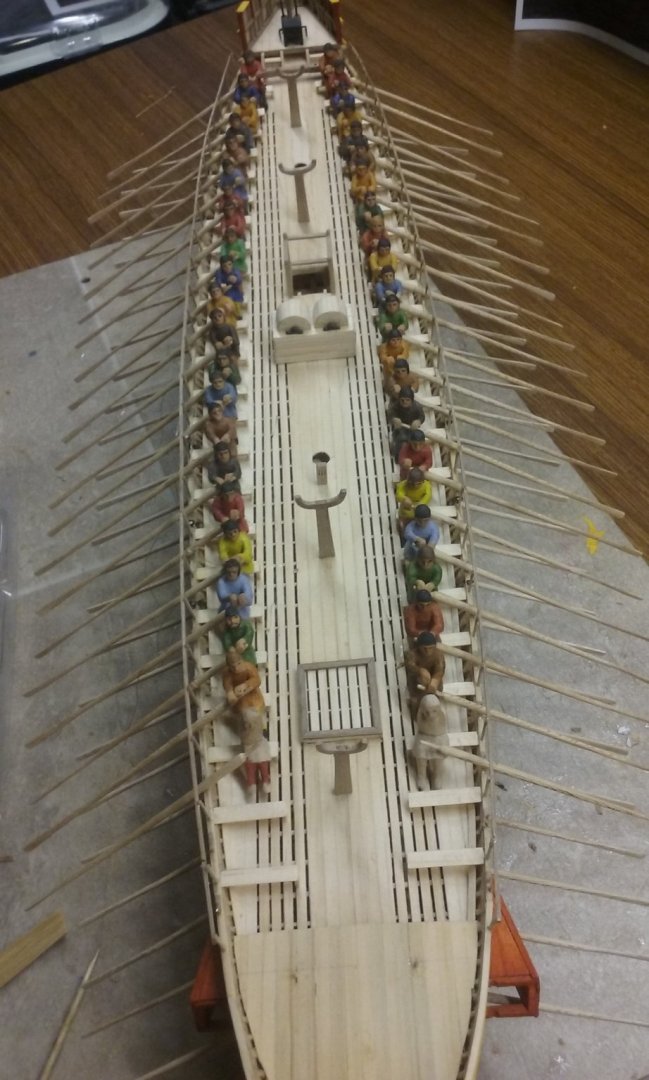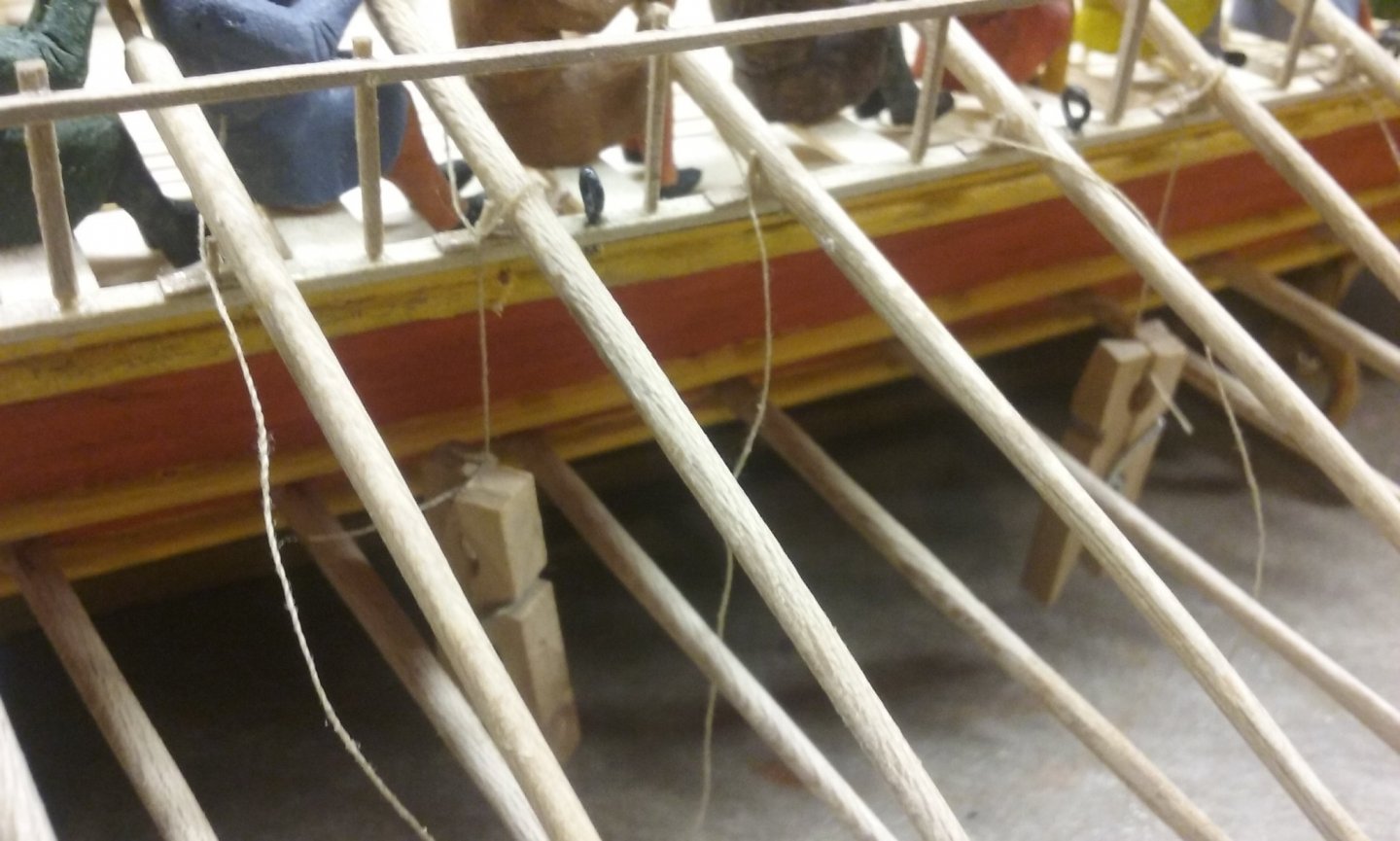-
Posts
7,986 -
Joined
-
Last visited
Content Type
Profiles
Forums
Gallery
Events
Everything posted by Louie da fly
-
And yet it became the dominant vessel type for at least a century, and was copied in the Mediterranean. So it must have had a lot going for it. Probably cargo capacity had a lot to do with it, and though the square rig had been common in the Mediterranean in Roman times, it had been largely replaced by the lateen. Was there something about square rig that gave it an "edge" over the lateen? You're doing great things - correcting such things as the frame that was too small will help you avoid problems later on. Keep up the good work.
-
OC, I'm gobsmacked by the quality of the paintwork on your figures. My dromon oarsmen are pretty much the same scale as yours, but the paintwork on mine is much more basic and plain - I haven't the skill to do the kind of shading you've done. (OTOH you didn't have to carve all yours! ) BTW, I don't know if anybody's mentioned it before, and at the risk of sending you off on another tangent, have you read "Death to the French" by C. S. Forester? It's a novel about a rifleman who gets separated from his unit during the British withdrawal to the Torres Vedras in the Spanish campaign, and lives off the land fighting the French until their retreat as the British advance, and he is able to rejoin his unit. Fictional (apparently) but with fascinating period detail of what it must have been like to serve as a rifleman at the time.
-
Woo hoo! I'm on MSW's facebook page! Apparently because I've been silly enough to carve all those oarsmen. But it's a real privelege to be up there with all those amazing examples of the shipmodeller's art. Speaking of oarsmen, I've completed another two and put them in place, and got a further two under way (the ones nearest the camera). Which means that once those are complete there'll only be one pair of oarsmen left to do! I won't know what to do with myself . . .
-
Yes, each step completed is not only a step towards the completed model, but it's also an achievement in itself. You're doing well and one day you'll be able to look back on this and say "It was really worth putting in that effort." And you'll have a model to be proud of.
- 74 replies
-
- mantua
- thermopylae
-
(and 1 more)
Tagged with:
-
Even if she is really a Man. Oh, no - that was Elizabeth I. But - depending on which body found on the ship was the Queen's - she either did or didn't have quite deformed feet, and bespoke shoes especially made to fit them. Well, that's convinced me - I won't be buying that stuff. Nope - it's quite visible, though probably not noticeable unless the attention is drawn to it. Oops. Sorry! Probably right, and you're completely right that now is the time to fix it, rather than come back later when it's much harder. Or worse, leave it and have it sneer at you every time you look at the completed model. It's all looking very good, Andrew. And I do like the way you are being so methodical and thoughtful about the whole process. Keep up the good work!
-
Getting better and better all the time. So you have a carpet monster, too? Mine is very voracious, but it's not always the thing at fault. I dropped a piece off the workbench, looked and looked for it for a long time with no success. Swept the carpet and sorted through what I'd swept up. Looked under all the furniture - nothing. Went off and did something else to get my mind off it, hoping the aliens who'd pinched it would have returned it when I came back. Nope. Then it occurred to me - it's cold where I live and I usually wear ugg boots when I'm modelling. Yep - the piece had fallen down my boot. Fortunately it wasn't anything fragile, so it hadn't broken.
- 211 replies
-
- prince of wales
- tamiya
-
(and 2 more)
Tagged with:
-

A Connecticut Yankee in California
Louie da fly replied to CTYankee's topic in New member Introductions
Hi James, and welcome to MSW! The Red Baron looks like a good kit to start off with. not too difficult, but with a few challenges to keep youfrom getting bored. Exactly. I know (to my cost - see my latest post on my own build log) what comes of hurrying too much. I'm afraid I share your problem with rushing into things- but not as bad as it was. I do find ship modelling develops forces you into being more patient. Follow your own advice, take it at your own pace, and enjoy the ride. After (not too long) a while you'll find yourself with a beautiful model that you can be proud of. Make sure you start a build log - it's the best way to get encouragement, help and advice. You'll find the people here are very friendly and helpful. And don't be afraid to ask questions - there's no such thing as a stupid one. A very good strategy. It'll pay off in the long run. And have fun with it! That's what it's all about. -
OOOPS! I got a little impatient. I was trying to remove this oarsman from his (supposedly temporarily glued) position on his bench so I could do the final carving, smoothing and painting. I'd gooped isopropanol onto the bench about three times - surely enough to weaken the bond so I could gently lever it off. Not so - I must have put too much glue on his seat, and not put enough isopropanol on to dissolve it, and not waited long enough. And the operative word above is "gently". Yes, I levered too hard, too soon. And crack - the bench broke away from its supports and in fact the wood of the bench broke as well. You can see a bit of it still stuck to the oarsman's seat . . . Not to worry. When I first made the benches I made a few too many. So it was the work of a few minutes to replace the bench with a new one, and all's well again. I still feel like a twit, though . . .
-
Hi Doug, and welcome to MSW! To be honest, I've found that model-building is like riding a bicycle - you might get a little rusty, but you never lose the ability even after many years away from it. And many of the skills you've developed from your earlier modelling are transferable to ships. I'm not familiar with any of these kits - they're all very attractive - but on googling them the Lady Nelson and Polaris both have step-by-step video instructions available on-line, and apparently the Smuggler has a 96 page instruction book. I see that the revenue cutter is a solid hull (and there's at least one buildlog on MSW for it) - I couldn't figure out whether the Smuggler is as well - it says "Laminated basswod hull" - does that mean it's solid? I think that any of these kits would be a worthwhile project. And while planking can be a pretty steep learning curve, that shouldn't be a reason not to go that route. There are plenty of examples and tutorials available, as well as lots of advice from people who've been there before. A methodical approach without rushing is probably your most valuable tool. And asking questions if you feel stumped. The membership here is very helpful and willing to give advice - often the problem you're up against has been encountered (and solved) before. And yes, it can feel intimidating seeing the excellent work the best of us produces. I'm still awestruck by the stuff other people produce - things I feel "I'll never be that good". But MSW has every level of skill and ability among its members, and every member started somewhere. You will make mistakes, you can be sure of that. But not mistakes all of us haven't made at some time or another. And most of them can be remedied. Down the track you'll probably look at your first build and think aargh - I got that wrong and that wrong, and I was too careless with the other thing. As we all do. It's a learning process, and as with anything else your skills (and your models) improve with each project you do. Each mistake gives valuable lessons for next time - if your second build isn't better than your first, there's something wrong. So don't get too intimidated, and don't let that be a reason not to start. When you've decided on the model you want to build and received your kit, make sure you start a build log. There are instructions here on how to go about it. Best wishes, and I look forward to seeing your ship taking form.
-
It's good that you've caught that problem with the decks at this stage, rather than having to fix it down the track which would involve a lot more work (and authentic Viking cursing!) The planking looks very good. Those are beautiful curves. Tell Floki to take a back seat.
-
This is a very interesting build. I am impressed by the way you've re-purposed everyday items to build the model instead of paying huge amounts for specialised materials (that may not produce a better result anyway).
- 19 replies
-
- golden yacht
- card
-
(and 1 more)
Tagged with:
-
Thanks for the likes. No - I'm very aware of how far the standard of this model falls below museum quality. Ask me again in another twenty years.
-
Beautiful job, Jeff. Not only the paint job under the waterline (which looks really good to me), but the rest of the hull as well. A seriously attractive model.
- 133 replies
-
That's beautiful crisp work, Peter. She's really starting to look like a ship. As far as motivation goes, little steps. Just do a bit as you find the time (and motivation). We're all our own worst critics, but from where I sit that's a very cool and beautiful model, and getting better all the time.
-
Wonderful work, Hellmuht. The sewing gives it a completely different look from most models.
- 158 replies
-
- byblos ship
- Egyptian
-
(and 1 more)
Tagged with:
-
Another three oarsmen complete and two more started. When I began I put the first few oarsmen in place somewhere amidships and worked both forward and aft from there, so I was able to add four new oarsmen each time - two (one each side) towards the bow of those already in place, and two aft. But now I've filled all the forward benches right up to the bow, so the only empty benches are towards the stern. So I can only add two oars and oarsmen each time. But on the bright side, there are now only 6 left to do (sigh) including the two aftermost guys who don't have their arms yet. In between times I've got back onto adding the ropes which hold the oars to the tholes - it's a tholeless task. Here are the larboard ones with a dab of glue holding each rope to its thole. I got a bright idea of how to pull the rope into its correct position across the oar, without having to sit like a twit holding each rope in turn while the glue dried. Whack a peg on the end, pull the rope taut and hang the peg from something convenient, so its weight keeps the rope taut and in position, and add another dab of glue to hold the rope to the oar at that point. And then once that's done, loop the rope right around the oar and repeat the process. Once all that's done I'll trim the hanging ends of the rope so it just looks like a loop around the thole and oar. I can only do a few at a time because the pegs get in each other's way. But once one set is done and glued in place, I can move on and do another set. Six more to go. I'm looking forward to it all being finished!
-
Hi Pchem, and welcome to MSW. I'm looking forward to seeing your Lynx build log.
-
That's a thought, Mark, but I really don't think this chest was intended as a seat for rowing, given its contents. Also the sloped face is the front - i.e. the one you face when you open the chest. If anything, that would mean the guy behind the oarsman would be the one who'd be able to open it . . . My belief is that this is such a highly decorated chest it probably did belong to Queen Asa, as KrisWood suggests. And as it was a burial, there would have been no reason for the oarsmen to leave them on board. It's thought one of the bodies was a maidservant sacrificed to accompany the Queen on her journey to the afterlife. But it would have been wasteful (and probably unpopular) to sacrifice the crew (and their chests) as well . . .
-
Christos, I agree with your interpretation for both the reasons you mention - firstly, that the red would be more visible if it was high up; second, that, as you say, Homer's word μίλτοπάρηοι relates to the upper part of the face. Of course that is always a problem with translating - a word in one language doesn't necessarily have exactly the same meaning as the "equivalent" word in the other, and though "Παρειές" translates into English as "cheek", it doesn't really mean exactly the same thing.
-
That does seem strange, but I doubt the inequality would be intended to make rowing easier - in fact I doubt that the chest was intended specifically to go on board a ship. The chests on board the Oseberg ship all contained women's possessions, except for one that contained wild apples - http://www.vikingage.org/wiki/wiki/Chests,_Caskets_%26_Boxes
About us
Modelshipworld - Advancing Ship Modeling through Research
SSL Secured
Your security is important for us so this Website is SSL-Secured
NRG Mailing Address
Nautical Research Guild
237 South Lincoln Street
Westmont IL, 60559-1917
Model Ship World ® and the MSW logo are Registered Trademarks, and belong to the Nautical Research Guild (United States Patent and Trademark Office: No. 6,929,264 & No. 6,929,274, registered Dec. 20, 2022)
Helpful Links
About the NRG
If you enjoy building ship models that are historically accurate as well as beautiful, then The Nautical Research Guild (NRG) is just right for you.
The Guild is a non-profit educational organization whose mission is to “Advance Ship Modeling Through Research”. We provide support to our members in their efforts to raise the quality of their model ships.
The Nautical Research Guild has published our world-renowned quarterly magazine, The Nautical Research Journal, since 1955. The pages of the Journal are full of articles by accomplished ship modelers who show you how they create those exquisite details on their models, and by maritime historians who show you the correct details to build. The Journal is available in both print and digital editions. Go to the NRG web site (www.thenrg.org) to download a complimentary digital copy of the Journal. The NRG also publishes plan sets, books and compilations of back issues of the Journal and the former Ships in Scale and Model Ship Builder magazines.



